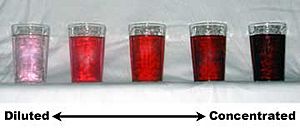Concentration facts for kids
In chemistry, concentration tells us how much of a specific substance is mixed into another substance. Think of it like making juice: if you add a lot of powder to a little water, your juice will be very concentrated!
The substance that gets dissolved (like the juice powder or the red dye in the picture) is called the solute. The substance that does the dissolving (like the water) is called the solvent. When the solute and solvent are mixed, they form a solution.
To make a solution more concentrated, you can either add more of the solute (more juice powder) or remove some of the solvent (let some water evaporate). To make a solution more diluted (less strong), you can add more solvent (more water) or take out some of the solute.
Contents
What is Concentration?
Concentration helps scientists and even chefs understand the strength of a mixture. For example, a concentrated cleaning product is very strong, so you might need to dilute it with water before using it. A concentrated fruit juice might be too strong to drink straight, so you add water to make it taste better.
Solutes, Solvents, and Solutions
- A solute is the substance that dissolves. It's usually the smaller amount in the mixture.
- A solvent is the substance that does the dissolving. It's usually the larger amount.
- A solution is the clear, uniform mixture that forms when a solute dissolves in a solvent.
How to Change Concentration
You can change how concentrated a solution is in two main ways:
- Making it more concentrated:
* Add more solute to the solution. * Remove some of the solvent (for example, by heating the solution to evaporate water).
- Making it more diluted:
* Add more solvent to the solution. * Remove some of the solute (though this is often harder to do).
Related topics
See also
 In Spanish: Concentración para niños
In Spanish: Concentración para niños


